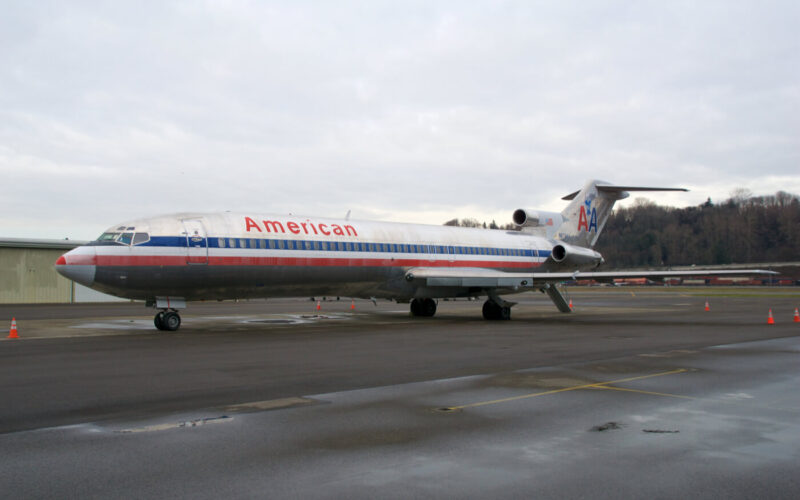The Federal Aviation Administration (FAA) of the United States has detected a potentially unsafe condition on the Boeing 727 airplane fuel system, which could result in an explosion. The agency has issued an airworthiness directive, despite the manufacturer’s protests.
The FAA has issued an Airworthiness Directive (AD) on December 31, 2019. In the directive, the authority outlines the findings that ignition sources inside the body-mounted auxiliary fuel tanks on Boeing 727 aircraft, exposed to flammable fuel vapors, could result in a fuel tank explosion. The ignition source can occur due to a combination of a preexisting failure that can remain undetected for multiple flights and one additional failure, as the agency explains.
The aircraft models to which the AD applies to are Boeing 727, 727-100, 727C, 727-100C, 727-200, and 727-200F series airplanes equipped with body-mounted auxiliary fuel tanks. The production of the 727 ran through 1960-1984; during this time, a total of 1,831 aircraft of the type were produced. According to the manufacturer, 272 aircraft of the type were manufactured equipped with such fuel tanks, only six of which are still flying in the United States.
Operators are now given a year to take measures to prevent development of an ignition source inside the body-mounted auxiliary fuel tanks due to electrical fault conditions. They can do that by either deactivating the high-flammability fuel tanks or modifying the fuel quantity indicating system on the aircraft. However, according to the agency’s estimations, the latter option is much more costly, as modification costs $753,000, while tank deactivation amount to only $850 per airplane.
The AD comes following a period of deliberation, after the FAA issued a notice of proposed rulemaking in 2016. During the period, Boeing has several times requested to withdraw the notice. The manufacturer has argued that the Model 727 planes did not have an unsafe condition and that the likelihood of a fuel tank ignition was very low given the size of the fleet and its remaining life, as pointed out by the authority. Nevertheless, the FAA disagreed with the requests and adopted the final rule as proposed with the exception of “minor” editorial changes.
Boeing 727 fuel tanks and the U.S. third deadliest aviation disaster
“A latent in-tank failure that provides a conductive path or reduces dielectric strength of the tank wiring or components, combined with an external wiring system failure that conducts power onto the tank wiring, could create an ignition source in the fuel tank of the Boeing Model 727 airplane,” the FAA has outlined. Classified as a “known combination of failures”, it has previously been detected in and as ruled as the most likely cause of an air accident involving another Boeing aircraft, the 747. The 727 and 747 model aircraft share similar fuel tank system architecture and design details.
On July 17, 1996, Trans World Airlines (TWA) Boeing 747-100, carrying out Flight 800, took off from John F. Kennedy International Airport (JFK) en route to Rome (Italy). Twelve minutes later, the aircraft suddenly exploded, crashing into the Atlantic Ocean. None of the 230 people on board survived.
The accident investigation by the National Transportation Safety Board took four years, and concluded in August 2000, that the probable cause of the accident was an explosion of flammable fuel vapors in the center fuel tank.
At the time, the tragic TWA flight became the second deadliest air accident in the United States, preceded only by American Airlines DC-10 crash upon takeoff in Chicago’s O’Hare International Airport in 1979, which claimed 271 lives. Nowadays, the TWA800 maintains the grim title as the third deadliest U.S. aviation accident, following American Airlines Flight 587 crash in 2001.
Boeing, FAA relationship
The FAA’s reputation has been badly damaged during the ongoing 737 MAX crisis. A wave of criticism over the agency’s certification of the MAX, which has been grounded since March 2019 following two fatal crashes that together killed 346 people, has raised suspicions of collusion between the regulator and Boeing and cast doubts over the U.S. authority’s ability to properly supervise aviation safety.
In October 2019, when Boeing then-CEO Dennis Muilenburg was questioned before the U.S. Senate, several senators suggested that the relationship between the Boeing company and the regulator that oversees the certification of its products might have been too “cozy”. Muilenburg denied the claim, expressing instead a belief in strong oversight in the aerospace industry and stating that the company had “a great deal of respect” for the FAA.
Yet the events that ensued suggest that if Boeing ever had a “too cozy” relationship with the FAA, the days now appear to be gone. In the months that followed, both parties have been taking an increasingly stronger stance against each other.
In November 2019, FAA announced that it would keep full control of certifying all individual new Boeing 737 MAX aircraft. Previously, the FAA and Boeing would both share the role of certifying new aircraft, where the issuing of airworthiness certificates at the final stage of production would be left to the planemaker.
On December 11, 2019, the FAA administrator Steve Dickson had confirmed the certification of the Boeing 737 MAX would not take place before 2020. A week later, Boeing announced that it would halt 737 MAX production starting the following month ‒ a move seen by some as Boeing’s attempt to pressure the agency.

